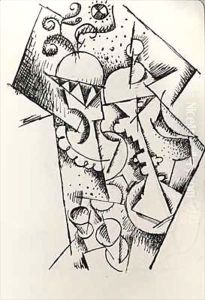Hans Bolz Paintings
Hans Bolz was a German artist known for his contributions to the avant-garde movement in the early 20th century. Born in 1885, Bolz grew up in a period of rapid change and innovation in the arts, which would deeply influence his artistic development. His work is often associated with Expressionism, a movement that sought to depict subjective emotions and experiences over realistic representations. However, Bolz's oeuvre also displays characteristics of other artistic movements of the time, such as Cubism and Futurism, reflecting the dynamic cross-currents of early 20th-century art.
Throughout his career, Bolz was engaged with the intellectual and artistic circles of his time, which included many of the era's leading figures. Despite his involvement with these groups, Bolz maintained a distinctive style that set his work apart from that of his contemporaries. His paintings are characterized by their vibrant colors, bold forms, and a sense of movement that seems to capture the tumultuous energy of the era. Bolz was particularly adept at using color and form to express complex emotional and psychological states, a hallmark of Expressionist art.
Sadly, Hans Bolz's career was cut short by his early death in 1918, at the age of 33, amid the turmoil of World War I. Despite his brief career, Bolz left behind a body of work that has continued to captivate and inspire subsequent generations of artists and art lovers. His paintings are seen not only as reflections of the individual angst and aspirations of a generation but also as significant contributions to the development of modern art. Bolz's legacy is preserved in the collections of several major museums, where his work continues to be studied and admired for its intensity and innovation.
